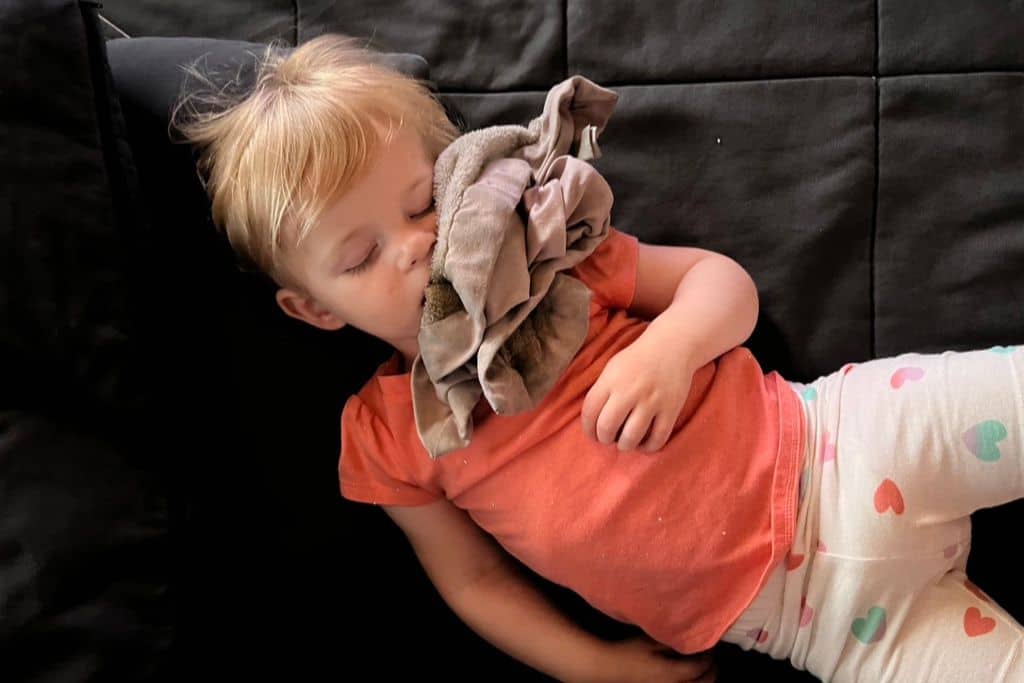6 Reasons Why a Baby Humps + What to Do About It
Many parents have come to me saying, almost in a whisper, “My baby is humping things. What do I do?“
As a therapist, I have worked with many children in different therapeutic settings. And my answer to these concerned parents is always the same: “Lots of children have humping behaviors. There is nothing to be ashamed of.“
It can be a nerve-racking, embarrassing, and very uncomfortable topic to discuss. But rest assured, your child’s humping behaviors are very common.
Is Humping Behavior Normal for Children?
Yes, humping behavior is completely normal for children.
Humping behaviors show up during different ages and stages of development. To get technical about it, renowned psychologists like Freud have noted thrusting and humping behavior as a normal part of development cycles for decades.
As adults, we immediately assume humping is a sexual act. But for toddlers, that’s rarely the case.
6 Reasons Why a Baby is Humping
Children exhibit humping behaviors because for one (or a combination of) six reasons:
1. Self-Soothing
The most common and likely reason your child is showing humping behavior is to self-soothe.
Just as a baby might suck their thumb, twist or pull their hair, snuggle with a favorite stuffed animal, humping is a way to pacify themselves.
Babies self-soothe regularly, especially if they are tired. Humping behavior will often show up near sleep times.

2. Exploring Their Body
Young kids are in a constant state of exploration. Everything is new, and they’re eager to learn. That includes wanting to learn about their own bodies.
Just as they show interest in their nose, kids show interest in their penis or vagina. Some ways they might explore these areas are by touching, rubbing, or pulling.
Body exploration is healthy and normal.
3. It Feels Good
While a child is exploring their body, they may discover that certain parts feel good to touch.
As adults, it’s hard to consider that humping behavior is not a sexual act. But it’s not.
Think about it this way: You get a mosquito bite. You’ve avoided touching it for fear of irritating your skin further. But it’s been driving you bonkers all day. Finally, after hours of agony, you cave and scratch it. And it feels so good.
That feel-good sensation is the same kids are experiencing while humping. Scratching a mosquito bite isn’t sexual and neither is humping behavior for children.
4. It Relieves Stress
Humping behaviors in children can be a form of stress relief. It’s similar concept to self-soothing.
If a child is feeling nervous, anxious, or overstimulated, they may resort to comforting habits, like humping.
5. Their Genitals are Irritated
Children may start touching themselves or use other humping behaviors to relieve some sort of irritation. It could be a yeast infection, insect bite, or rash that is causing them discomfort.
If this is the case, call your pediatrician and discuss how best to treat the condition.
6. Exposed to Explicit Images or Sexual Abuse
This is a very unlikely reason a child is showing humping behaviors, but one to consider, nonetheless.
If a child has been exposed to explicit images or is being sexually abused, they may start to mimic the images or acts they have been a part of.
If abuse is occurring, a child may go further than the occasional humping behavior. The child might try to inappropriately or discretely touch animals, children, or other adults.
If you have any reason to suspect your child has been abused, seek professional help immediately. You can find resources through your county agency, local law enforcement, or reach out to any mandated reporter (like a psychologist, social worker, or school counselor).
Should I Stop My Baby’s Humping Behavior?
When a child is engaging in humping behaviors, you may feel confused, ashamed, or even defensive. These are normal reactions to an uncomfortable and taboo subject.
If your baby is humping for any of the first four reasons listed above (self-soothing, exploration, positive sensation, or stress relief), then I wouldn’t intervene.
Ignore the behavior as best you can. And under no circumstance should you shame or tease your child for engaging in humping behavior. More likely than not, it will gradually subside on its own.

As previously stated, if you are concerned that your child is humping as a result of skin irritations or being exposed to explicit images or abuse, seek professional help right away.
Humping Behavior in Children F&Q:
Here are some commonly asked questions about a child’s humping behavior:
What does “humping behavior” include?
Humping behavior is typically comprised of thrusting, gyrating, rubbing, or pulling.
However, your child might not be outwardly humping items. Rather, they (girls specifically) may be crossing their legs or tensing up. These actions are still categorized as normal humping behaviors.
How do I know if my child is humping?
You may witness your child humping a stuffed animal, blanket, or mattress while in their crib or bed.
It’s possible to find out about your child’s humping behavior from other caregivers such as daycare providers or grandparents.
How should I respond if someone tells me my child is humping?
Though you may be surprised to learn about your child’s humping behavior, it is best to take in the information in a calm and curious way.
Thank the person for telling you. Then you can inform them that you will continue to learn more about why your child is showing humping behaviors.
What are common items my child may hump?
If a child is humping, it’s usually done in a place where they feel safe and secure. They also may use items that bring them comfort. Common items include:
- Stuffed animals or other comfort toys
- Blankets
- Pillows
- Mattresses
- Chairs
Should I intervene when my child is humping?
You probably don’t need to stop the humping behavior. Chances are, it’s making you more uncomfortable than anything else.
If your child is touching animal, children, or other adults, then it’s time to talk about appropriate and inappropriate areas of touch.
When will my baby stop humping things?
Majority of children that hump are between the ages of two and three. But children may start humping as early as 18-months-old. And humping behaviors may last until they are 6-years-old.
If your child is six or older, you may want to talk to your pediatrician about how to alter the behavior.
The Wrap Up: 6 Reasons Why a Baby Humps
There are 6 mains reasons to explain why a baby is showing humping behaviors including: self-soothing, body exploration, it feels good, to relieve stress, an irritant near their privates, or sexual exploitation.
As you child is most likely to be humping as a way to self-soothe, there is no need to stop the behavior. If he or she is humping as a result of the last two reasons (irritated genitals or abuse), seek professional help immediately.
Humping behaviors, though possibly embarrassing and shocking, are very common in children.
Read next: 25 Qualities of a Good Mother
